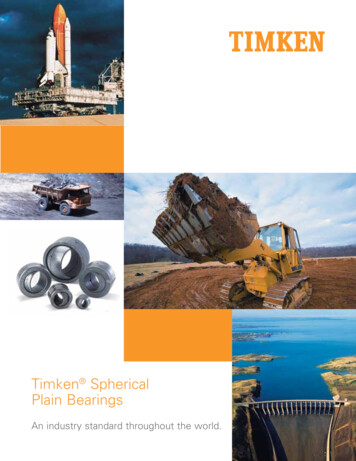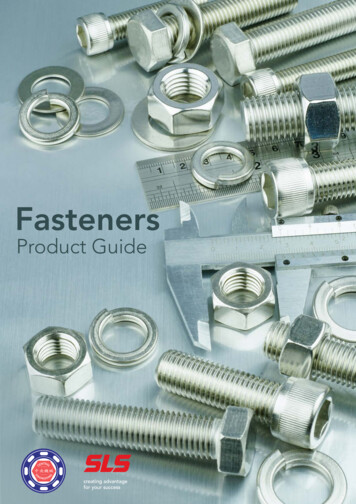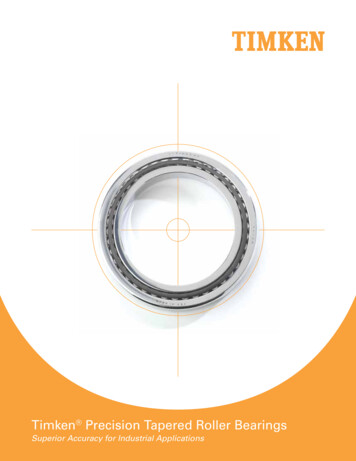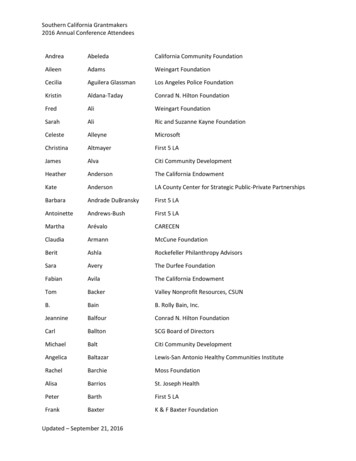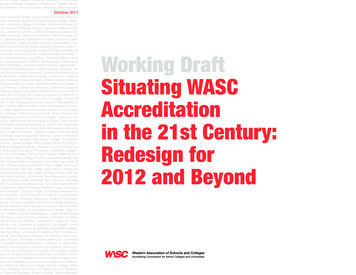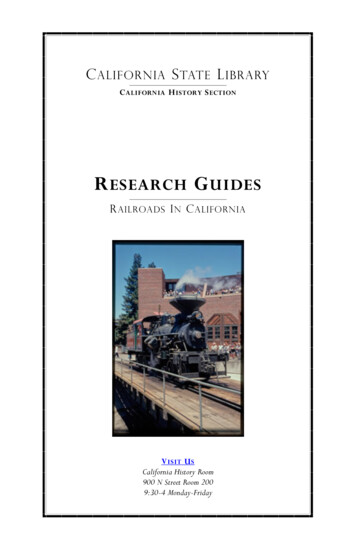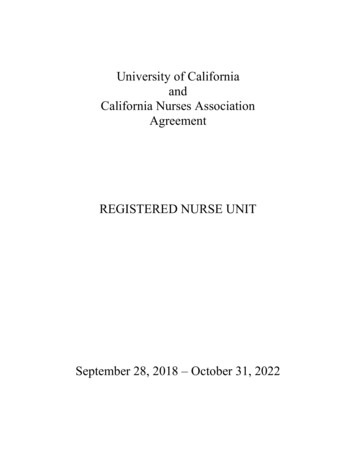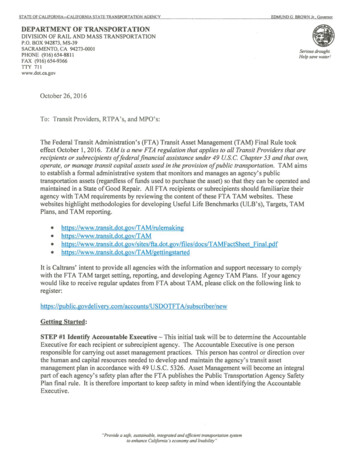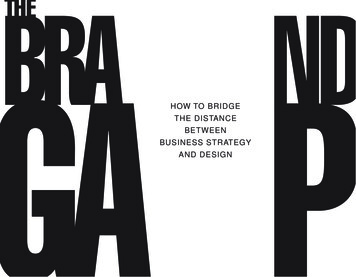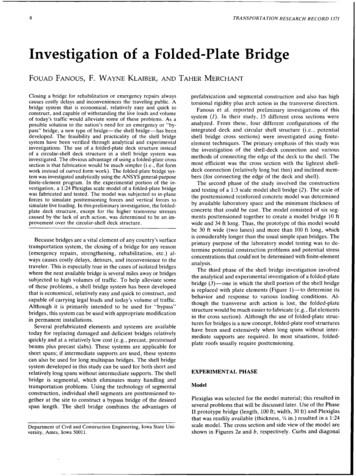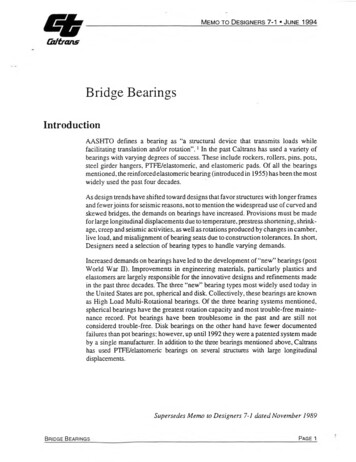
Transcription
M e mot oD e s ig n e rs7-1 * J u n e 1994Bridge BearingsIntroductionAASHTO defines a bearing as “a structural device that transmits loads whilefacilitating translation and/or rotation ” . 1 In the past Caltrans has used a variety ofbearings with varying degrees of success. These include rockers, rollers, pins, pots,steel girder hangers, PTFE/elastomeric, and elastomeric pads. Of all the bearingsmentioned, the reinforced elastomeric bearing (introduced in 1955) has been the mostwidely used the past four decades.As design trends have shifted toward designs that favor structures with longer framesand fewer joints for seismic reasons, not to mention the widespread use of curved andskewed bridges, the demands on bearings have increased. Provisions must be madefor large longitudinal displacements due to temperature, prestress shortening, shrinkage, creep and seismic activities, as well as rotations produced by changes in camber,live load, and misalignment of bearing seats due to construction tolerances. In short,Designers need a selection of bearing types to handle varying demands.Increased demands on bearings have led to the development of “new” bearings (postWorld War II). Improvements in engineering materials, particularly plastics andelastomers are largely responsible for the innovative designs and refinements madein the past three decades. The three “new” bearing types most widely used today inthe United States are pot, spherical and disk. Collectively, these bearings are knownas High Load Multi-Rotational bearings. Of the three bearing systems mentioned,spherical bearings have the greatest rotation capacity and most trouble-free maintenance record. Pot bearings have been troublesome in the past and are still notconsidered trouble-free. Disk bearings on the other hand have fewer documentedfailures than pot bearings; however, up until 1992 they were a patented system madeby a single manufacturer. In addition to the three bearings mentioned above, Caltranshas used PTFE/elastomeric bearings on several structures with large longitudinaldisplacements.Supersedes Memo to Designers 7-1 dated November 1989Br id g e Bea ring sPag e 1
M e mot oD e s ig n e rs7-1 « J u n e 1994Bearing SelectionBearing selection is influenced by many factors such as loads, geometry, maintenance, available clearance, displacement, rotation, deflection, availability, policy,designer preference, construction tolerances and cost. The designer must consider allthe applicable variables early in the design stage and design the structure and bearingas a unified system. Too often bearings are selected at the last minute when forces andavailable space are fixed. Such an approach increases the chances of future maintenance problems.The official policy of the Division of Structures is to avoid using an alternativebearing system where a conventional reinforced elastomeric pad can provide therequired characteristics through shear deformation. When the practical limits ofelastomeric bearing pads are exceeded, designers should consider using PTFE/spherical or PTFE/elastomeric bearings. The three bearing systems mentionedshould provide enough versatility to satisfy the design requirements of most structures designed by the Division of Structures. Other bearing systems may be appropriate for special circumstances; designers should consult with the Bearing TechnicalSpecialist for unique applications.On widenings, designers are cautioned against mismatching bearing types. It hasbeen common practice to use elastomeric bearing pads, a yielding bearing, to widenstructures supported on steel rocker bearings, an unyielding bearing. While thispractice has worked satisfactorily on short to moderate length structures, it hascreated problems when thick elastomeric bearing pads have been used on structureswith long spans . 6Pag e 2Br id g e Bea ring s
Reinforced Elastomeric Bearing PadsGeneralReinforced elastomeric bearing pads, designed in accordance with Bridge DesignSpecifications, Section 14, should be considered the preferred type of bearing for allstructures. The typical hinge or abutment configuration using many small elastomericbearing pads has proved highly reliable and redundant. In addition, these bearings areextremely forgiving of loads and translations exceeding those considered in design.Designing and Detailing NotesThe following data illustrates our current practice and provides practical informationabout elastomeric bearings. In addition, design examples and various charts in thismemo provide background for the Bridge Design Specification.Pad thickness is determined in increments of x/i inch. Minimum laminated padthickness is one inch. Maximum laminated pad thickness is 6 inches at abutments and4 inches at hinges. Plan dimensions (length, width) are determined in two inchincrements. Maximum dimensions should not exceed 30 inches.The minimum shape factor (5) for any reinforced bearing shall be 5.0. Unless sheardeformation is prevented, the average compressive stress, 5C, in any layer of anyreinforced bearing with an S 5.0 shall not exceed 800 psi. The minimum averagecompressive stress due to dead load will not be less than 200 psi. The TransportationLaboratory has found that as overall pad thickness increases, the compressivestiffness of the pad decreases although the shape factor is held constant . 3Rotational stresses may be minimized by specifying the smallest pad width possiblewithin the limits of the application. Orient rectangular bearing pads so that the long sideis parallel to the axis about which the largest rotation occurs (see Figure 1, page 9).All pads at a hinge or abutment should be the same size, and oriented similarly. Ensurethat the orientation is clearly detailed.Bearing pads on skewed structures should be oriented parallel to the principal rotationaxis (see Figure 1). When insufficient seat width exists, the bearing pads may beoriented normal to the support. The effects of skew and/or curvature must beconsidered. This may result in varying the pad spacing to accommodate the increasedload at the obtuse comer. Minimum loads must be maintained to ensure that slippage(movement) of the bearing does not occur.Br id g e BearingsPag e 3
Slippage will be prevented by maintaining a minimum compressive force five timesgreater than the largest possible shear force under all service load conditionsincluding live load plus im pactThe effects of prestress shortening, creep, shrinkage, and thermal movements will beincluded in bearing pad designs. The Bridge Design Specifications (Article 14.2.6)state that the shear deformation shall be taken as the maximum possible deformationcaused by creep, shrinkage, post tensioning, and thermal effects unless a positive slipapparatus is installed.Testing at the Transportation Laboratory with positive slip apparatuses have shownthat prestress shortening may be partially accommodated by placing a greasedgalvanized sheet metal plate (sliding bearing) above the pad. The plate should extenda minimum of one inch in all directions beyond the calculated movement. (See Figure2, page 10.) Long term tests have demonstrated that 50 percent of the total anticipatedprestress shortening may be relieved by this sliding bearing without any significantshear deformation of the elastomeric bearing pad. The remaining prestress shortening, creep and shrinkage must be included in the bearing pad design. Note thatprestress shortening may continue beyond the calculated long term shrinkage,particularly in the case of shallow structures with depth/span ratios less than 0.04.The prestress shortening percentage (50 percent) used to design the bearing pad maybe reduced at hinges that have delayed hinge closure pours when the sliding bearingdetail is utilized. The reduction may be calculated by adding 20 weeks to the durationof the closure pour waiting period and determining a new shortening value from theprestress shortening curve (Attachment 1).The designer needs to specify silicone grease on the plans when using the slidingbearing to differentiate it from the previously used multipurpose, automotive andindustrial greases. Testing at the Transportation Laboratory has demonstrated thatmultipurpose petroleum base greases do not provide the desired sliding effect andmay damage the elastomer because they are absorbed by the pad in a very short periodof time.Minimum edge distance to any vertical face (backwall, face of abutment or hingeseat) should be equal to “t" (pad design thickness), or 3 inches, whichever is greater.For cast-in-place structures, surround the bearing pads with polystyrene of the samethickness as the actual pad thickness. (See Figure 3, page 10.)Plain pads are acceptable during stage construction of precast prestressed girdersuperstructures that are continuous for live load where in the final condition the bentcap becomes monolithic with the girders and slab.Pag e 4Br id g e Bearing s
Steel reinforced and fabric reinforced pads have different design criteria. Wherepossible, the designer should prepare both designs (with one set of details) and allowthe contractor the choice as specified in Section 51-1.12H of the Standard Specifications. The following is an example of a note that should be shown on the plans:“Fabric reinforced elastomeric bearing pads 22" x 28" x 2" or steel reinforcedelastomeric bearing pads 2 0 " x 26" x 2 " (elastomer only).”In most cases the designer need not be aware of the increase in thickness due to thesteel reinforcing, since the design thickness relates to the thickness of elastomer, andchanges due to the actual thickness are taken care of in the specifications and duringconstruction. Exceptions may include retrofit projects where the actual thicknessshould be shown on the plans. In these cases a substitution would not be allowed, andthe plans should state this clearly.Properties of ElastomerDurometer H ardness. 55 5*Creep in Com pression.25% of initial vertical deflectionShear Modulus (Adjusted)@ 70 F@ 20 F@ 0 F@ -2 0 F 1.10 x 135 1.25 x 135 1.90 x 135 135 psi149 psi169 psi257 psi“Shear modulus ( G), is the most important material property for design, and it is,therefore, the preferred means of specifying the elastomer. Hardness has been widelyused in the past because the test for it is quick and simple. However, the resultsobtained from it are variable and correlate only loosely with shear modulus.” 1The shear modulus of elastomer, obtained from testing, is approximately 100 psi at70 F.3 The design value was increased to 135 psi at 70 F to include a safety factorof 35 percent against horizontal overloads. For design calculations use the modulusat 0 F, (169 psi), unless temperatures will be substantially lower.* Railroads require 60 5 hardness on their structures. Specifications handles the change and thereis no change in design.Bridg eB earin gsPag e 5
Elastomer properties are in accordance with the Research Report, “A LaboratoryEvaluation of Full Size Elastomeric Bridge Bearing Pads,” dated June, 1974, by theTransportation Laboratory of the State of California, except as noted.Design Criteria1 . Temperature movement shall be calculated as per the examples in this memoran-dum. In calculating movement, use 1V4 times the coefficients, as it is not possibleto always place the pad at a “mean” temperature. Rise and fall temperature valuesare given in the Bridge Design Specifications, Article 3.16.2 . Long term prestress shortening and shrinkage shall be included in the bearingmovement calculation. Prestress shortening per 100 feet of contributory lengthwill equal 0.10 feet for post tensioned concrete structures, and a minimum of 0.01feet for pretensioned concrete structures. Shortening (shrinkage) of conventionalreinforced concrete structures will equal a minimum of 0.005 feet per 100 feet ofcontributory length. Fifty percent of the prestress shortening may be discountedwhen the sliding bearing is used. (See Figure 2, page 10.)3. Pad thickness shall not exceed lA of the length or width, or be less than twice thecalculated horizontal movement. Maximum thickness for plain pads is xh inch.Maximum thickness for laminated pads is 6 inches at abutments and 4 inches athinges. Minimum thickness for laminated pads is 1 inch (two 14-inch layers).When design procedures require a pad thickness greater than the maximumrecommended thickness, investigate the use of F I FE bearings.4. Average pressure on the pad shall not exceed 800 psi under a service loadcombination of dead load plus live load not including impact. For steel reinforced bearing pads with a Shape Factor 7.5, the average pressure shall notexceed 1,000 psi. Minimum pressure on any pad due to dead load shall not beless than 200 psi.5. Initial vertical deflection (compressive strain) shall not exceed 7 percent (excluding the effect of rotation) of the uncompressed thickness of the pad.Determine the initial compressive strain from Figure 4A or4B (page 11 and 12),“Compressive Strain, Percentage”, using the compressive stress and shape factor.Pag e 6Br id g e Bear in g s
Note: one loaded surface areaShape Factor -------------------------------total free - to - bulge areaW x L2( W L) x (thickness per layer)WhereL - length of bearing pad in direction of horizontal movement;W width of bearing pad normal to direction of horizontal movement.For laminated pads, since the thickness per layer is always W , the formulareduces to:WLShape Factor -------W L6. If some combination of service loads (including live load plus impact) existswhich causes a shear force greater than Vs of the simultaneously occurringcompressive force, the bearing should be secured against horizontal movement.No experimental determination has been made of the starting friction betweenbearing pad and concrete or steel. But it has been observed in laboratory tests onfull size pads that slippage does not occur so long as the
live load, and misalignment of bearing seats due to construction tolerances. In short, . Long term prestress shortening and shrinkage shall be included in the bearing movement calculation. Prestress shortening per 100 feet of contributory length will equal . 0.10. feet for post tensioned concrete structures, and a minimum of . 0.01 . feet for pretensioned concrete structures. Shortening .

